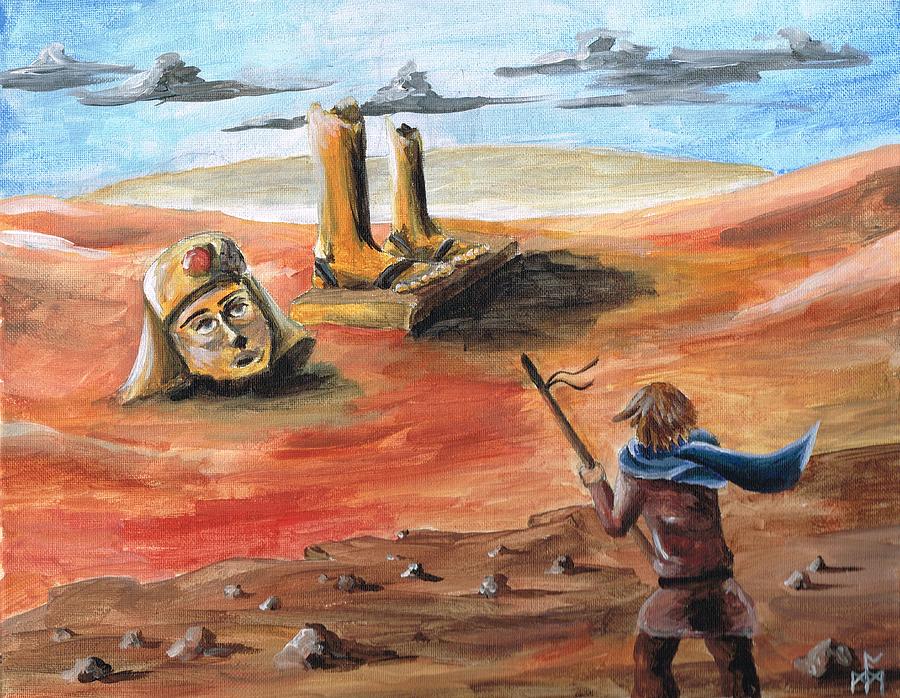Ozymandias - By Percy Bysshe Shelley
Ozymandias
By Percy Bysshe Shelley
I met a traveller from an antique land,
Who said – “Two vast and trunkless legs of stone
Stand in the desert… Near them, on the sand,
Half sunk a shattered visage lies, whose frown,
And wrinkled lip, and sneer of cold command,
Tell that its sculptor well those passions read
Which yet survive, stamped on these lifeless things,
The hand that mocked them, and the heart that fed;
And on the pedestal, these words appear;
My name is Ozymandias, King of Kings;
Look on my Works, ye Might, and despair!
Nothing beside remains. Round the decay
Of that colossal Wreck, boundless and bare
The lone and level sands stretch far away.”[1]
 Anderson, M. (2019). Ozymandias. [image]. The above shows a painting by Mitry Anderson of the poem 'Ozymandias'. |
This is a hugely interesting sonnet, with many different aspects and concepts to be explored. The poem speaks of the traveller, whom the information about the sculptor and the statue is passed forward to us, regarding the “King of King’s”, Ozymandias. The poem is said to be a warning to people about the arrogance of powerful leaders, alongside the idea that they were one so high and mighty, now so futile and broken. It also explores the idea through metaphor and juxtaposition of the ‘ultimate powerlessness of man[2]’. It has been said that the statue that inspired Percy Shelley to write the poem was the gigantic statue of Ramses II. The main themes of the poem involve: pride, power, force, superiority, arrogance, fear, futility and worship of a Godly, higher power. However, in the end, it is nature and its own forces that have torn the statue from its high standing to leave it as rubble coating the ground of the seemingly sacred ‘antique land’ that the traveller depicts. In this way, Shelley evokes the idea of futility. ‘Its sculptor well read those passions’, from the depiction given previously in the sonnet, we form an idea of the great scale and therefore, effort and time that would be required for such a feat of art. This idea of futility highlights how the traveller describer the ‘decay of (that) colossal Wreck’, where ‘nothing beside remains’ are left of this incredible statue of the ‘King of Kings’. The futile effort of the sculptor is left to be empathised with, whilst the traveller appears to somewhat mock this display of art that has not managed to ‘survive’ the test of time. That is, besides the pedestal that reads rather ironically to ‘Look on my Works, ye Might, and despair!’, as if viewers should somewhat fear the overwhelming power of this great leader. However, the arrogance of this statement is being ‘mocked’ by the traveller, as there is nothing left to fear. The man himself who inspired the statue is no longer a threat, but rather dead – and along with him, his statue that has fallen to a pile of rubble from the proud and powerful high-standing it once had, back when it was respected and praised.
This poem is a sonnet, consisting of fourteen lines, constructed in one continuous stanza. The rhythm of the poem is Iambic Pentameter, through the use of stressed and unstressed syllables throughout the poem. The rhyme scheme of the poem is rather peculiar, following the schematised form of ABABACDCEDEFEF[3]. Due to this peculiar rhyme scheme, this poem cannot be labelled with the usual Italian or Shakespearean sonnet. It uses rhyming couplets for emphasis, which functions to further engage the reader in the story being told. The use of rhyme often makes a poem lyrical and melodic, as a sonnet is expected to be. The additional features of alliteration used, again captures the intrigue of the reader and make the poem more accessible to read. Alliteration is shown when Shelley writes: ‘an antique’ and ‘survived, stamped’ and ‘sands stretch’ (which also involve the use of sibilance). It could be said that vague listing is also used within the poem through the description of the shattered statue, ‘Near them, on the sand, half sunk, a shattered visage lies, whose frown, and wrinkled lip, and sneer of cold command’, presenting a form of continuous listing, to further the imagery. This listing also employs the use of frequent pauses, which helps to break up the melodic rhythm of the poem, which again may be used to intrigue the reader, as the continued static pauses are unexpected. The tone of the poem appears to be reflective, when considering the view-point of the sculptor and his futile efforts which have fallen somewhat in vain, though also slightly critical or satirical when looking from the perspective of the traveller, laughing at the power that has fallen, with the only remains being the name that titles the poem and word of his great power.
[1]Poetry Foundation. (2019). Ozymandias by Percy Bysshe Shelley. [online] Available at: https://www.poetryfoundation.org/poems/46565/ozymandias [Accessed 27 Sep. 2019].
[2]Poetry Foundation. (2019). Ozymandias by Percy Bysshe Shelley. [online] Available at: https://www.poetryfoundation.org/poems/46565/ozymandias [Accessed 27 Sep. 2019].
[3]Poetry Foundation. (2019). Ozymandias by Percy Bysshe Shelley. [online] Available at: https://www.poetryfoundation.org/poems/46565/ozymandias [Accessed 27 Sep. 2019].


This great Ellyse. Plenty of good analysis of the poem. To complete, think about the significance to a) Romanticism, b)the time period (post-French Revolution), c) find critical writing on the poem and introduce that into your writing 'Critical Response' d) perhaps consider the notion of the sublime:
ReplyDeletehttps://www.youtube.com/watch?v=t0fHjIPpR-Q
Nice work
I think the end rhyme scheme is interesting in a site of shifting sand and shifting authorship with half-rhymes and assonance. And note the deferred authorship of the opening line
ReplyDelete